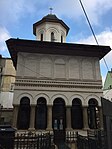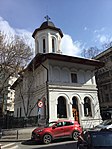Casa Capșa
1852 establishments in WallachiaCalea VictorieiHistoric monuments in BucharestHotels in BucharestRestaurants in Romania

Casa Capșa is a historic restaurant in Bucharest, Romania, first established in 1852. At various times it has also included a hotel; most recently, it reopened as a 61-room hotel 17 June 2003. "…long a symbol of Bucharest for its inhabitants… Capșa is not only associated with its exquisite pastry products, but also for a hectic literary life of yore… a welcoming place for Romanian writers where they could meet, talk and…associate."The restaurant stands on Calea Victoriei at the corner of Edgar Quinet Street, across from the Hotel Capitol and diagonally across from the Palace of the National Military Circle.
Excerpt from the Wikipedia article Casa Capșa (License: CC BY-SA 3.0, Authors, Images).Casa Capșa
Calea Victoriei, Bucharest Centrul Istoric (Sector 1)
Geographical coordinates (GPS) Address Nearby Places Show on map
Geographical coordinates (GPS)
| Latitude | Longitude |
|---|---|
| N 44.435527777778 ° | E 26.098075 ° |
Address
Hotel Casa Capșa
Calea Victoriei 36
010082 Bucharest, Centrul Istoric (Sector 1)
Romania
Open on Google Maps











